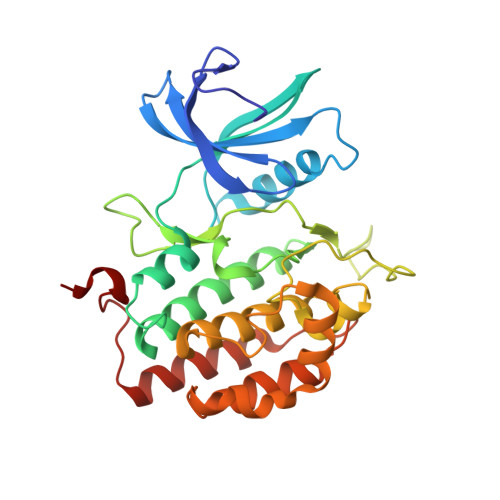TDP-43 Modulation by Tau-Tubulin Kinase 1 Inhibitors: A New Avenue for Future Amyotrophic Lateral Sclerosis Therapy.
Nozal, V., Martinez-Gonzalez, L., Gomez-Almeria, M., Gonzalo-Consuegra, C., Santana, P., Chaikuad, A., Perez-Cuevas, E., Knapp, S., Lietha, D., Ramirez, D., Petralla, S., Monti, B., Gil, C., Martin-Requero, A., Palomo, V., de Lago, E., Martinez, A.(2022) J Med Chem 65: 1585-1607
- PubMed: 34978799
- DOI: https://doi.org/10.1021/acs.jmedchem.1c01942
- Primary Citation of Related Structures:
7Q8V, 7Q8W, 7Q8Y, 7Q8Z, 7Q90, 7QHW - PubMed Abstract:
Amyotrophic lateral sclerosis (ALS) is a fatal neurodegenerative disease without any effective treatment. Protein TDP-43 is a pathological hallmark of ALS in both sporadic and familiar patients. Post-translational modifications of TDP-43 promote its aggregation in the cytoplasm. Tau-Tubulin kinase (TTBK1) phosphorylates TDP-43 in cellular and animal models; thus, TTBK1 inhibitors emerge as a promising therapeutic strategy for ALS. The design, synthesis, biological evaluation, kinase-ligand complex structure determination, and molecular modeling studies confirmed novel pyrrolopyrimidine derivatives as valuable inhibitors for further development. Moreover, compound 29 revealed good brain penetration in vivo and was able to reduce TDP-43 phosphorylation not only in cell cultures but also in the spinal cord of transgenic TDP-43 mice. A shift to M2 anti-inflammatory microglia was also demonstrated in vivo . Both these activities led to motor neuron preservation in mice, proposing pyrrolopyrimidine 29 as a valuable lead compound for future ALS therapy.
Organizational Affiliation:
Centro de Investigaciones Biológicas Margarita Salas─CSIC, Ramiro de Maeztu 9, 28040 Madrid, Spain.

















